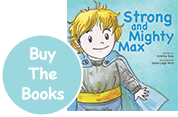Kristina Gray is interviewed on BBC Radio Coventry and Warwickshire about Edition Two of Strong and Mighty Max
Blog
Positive message of acceptance. Bravo!
![]()
My Baby girl was born with a form of dwarfism and it became apparent very quickly that there weren’t many books or toys out there that embraced her special differences. I heard about Strong and Mighty Max and I was so excited to order a copy. It is brilliant. Full of beautiful lessons about life, written in a fun and uplifting way. I can’t recommend it highly enough.
Cruzanne – 5 October 2018
October is Dwarfism Awareness Month
Many Charities have a time of the year in which they specifically promote and educate the public about a specific cause, campaign or issue to help raise positive awareness about their given concern. For families whose lives are impacted by the medical condition of dwarfism, October is the month. The Restricted Growth Association (RGA, UK Charity) and its members use this opportunity to post on social media facts about dwarfism related conditions. For example, achondroplasia, the most common form of dwarfism, impacts approximately 1 in 25,000 babies in the UK who will be born with this condition every year. The majority of children born with the condition have no previous family history, in fact 80% of children are born to average height parents. (Some Facts About Achondroplasia )
There are many misconceptions about dwarfism, often because of the portrayal of the condition in the media. This year has been a great opportunity to educate the public with positive representations of dwarfism, and it has been a privilege to be engaged with television documentaries, regional television and radio debates.
Edition Two of Strong and Mighty Max was released at the end of July 2018 and is now available to order online. It is great also to have an ebook edition released which makes the story so much more accessible around the world. No sooner had the book been released and BBC4 aired a critically acclaimed documentary described as ‘brilliant’ by The Independent and ‘best TV’ by The Guardian. Factual Programmes such as this do a lot to challenge historical representations of people with dwarfism. My son and I were both interviewed for the programme and it gave us the opportunity to give a contemporary face to the human story.
https://www.youtube.com/watch?v=09b3fA88Jqc&list=UUu9vakTeR-7AhgZAGKI26pw&index=6
BBC Coventry and Warwickshire produced a short video in September which showcased Strong and Mighty Max Edition Two. This has been my contribution to Dwarfism Awareness Month as this new edition seeks to educate people about differences and the importance of kindness. It also challenges people to see beyond stereotypes and has a dedicated learning section for schools which highlights positive role models. The learn section of my website compliments the learning experience that can be gained from the book and it is my hope that schools will use it as a go to place to look at the issue of disabilities and differences
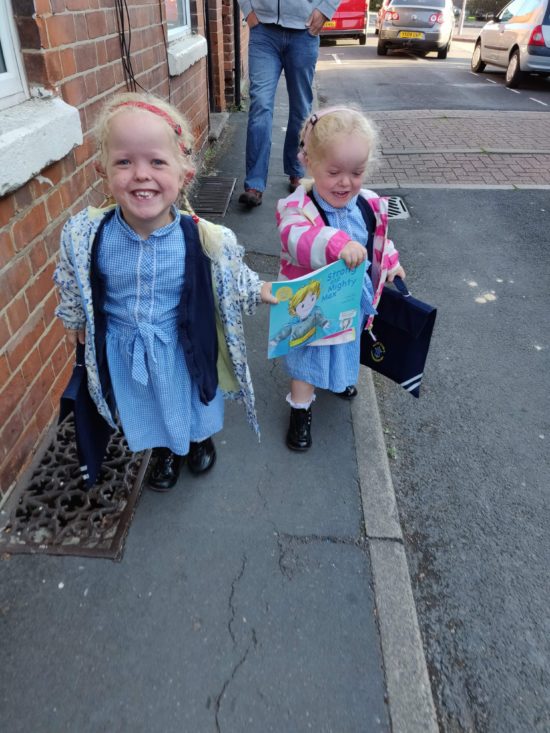
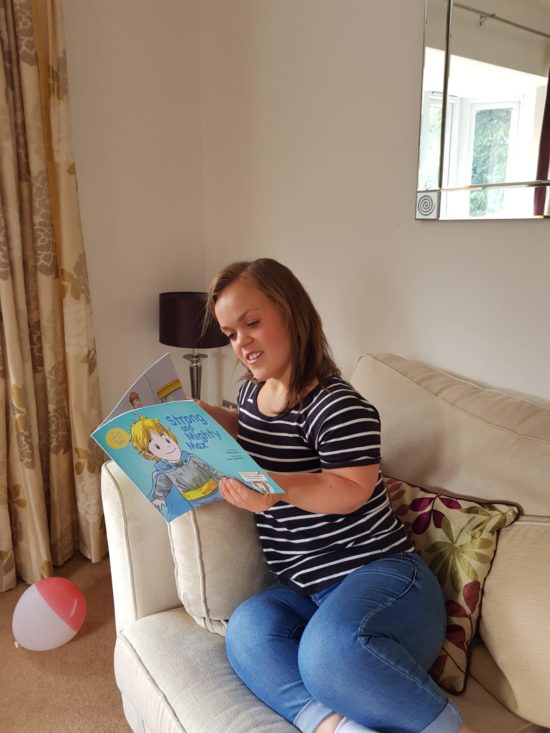
Paralympic swimmer, Ellie Simmonds, is one of the role models who features in the back of edition two. It is great to know that she too is enjoying the story. It is always wonderful to receive positive feedback from children and families who are enjoying Strong and Mighty Max. Just knowing that this book is a useful tool to help explain to their peers, family members and local schools is the best positive awareness raising that I could have hoped for. Education is key to understanding differences. If children learn from a young age that people with dwarfism are just the same as them, apart from the fact that their bones grow more slowly, hopefully they will be future advocates to challenge prejudice when they see it.
It was great to be given the opportunity to share this on BBC Radio Coventry and Warwickshire. The interview below is from the Vic Minett Show which broadcast on 17/09/18
There has been a lot of positive media in the run up to dwarfism awareness month, there has also been some controversial debates that caused a national press frenzy in the UK around the topic of ‘dwarf wrestling’. American performers due to debut shows across the UK were challenged by national charity RGA and its membership who campaigned against venues showcasing what had been advertised as ‘family shows…not seen since the Victorian era’. The language used to promote the wrestling was derogatory towards people with the condition describing them as ‘midgets’ and referring to the performance as a ‘side show’ with ‘dwarf tossing’ as part of the performance. As a result of the RGA’s successful campaigning, venues in Leicester and Dorset issued statements to say they would no longer be hosting these events. Venues is Wales and Liverpool are still scheduled to go ahead in October (the irony of dwarfism awareness month) This of course caused a back lash against the charity who were deemed to be ‘offended’ and in opposition to the wrestlers rights to earn a living in whatever way they choose. This will always be a moral debate, the actions of a few versus the well-being of the many. ITV and BBC both gave prime time television debate to this discussion, I would argue Piers Morgan gave voice to the wrestlers and the status quo whereas the BBC and the Victoria Derbyshire show presented a more balanced piece. However in all of this debate there are very important opportunities for educating the general public, who perhaps would not understand the issue with such shows in the first place.
Erin Pritchard, a lecturer in disability and education at Liverpool Hope University, wrote a piece for the Independent @indyvoices. Her voice in the debate was powerful for two reasons. 1) She has restricted growth herself and 2) She works in the city that still plans to host an event in October.
“As a person with dwarfism, I feel safer now that ‘midget wrestling’ events have been cancelled”. To read her arguments in full click here.
My contribution to the debate featured on BBC Radio Wales and the Dot Davies show. To listen to the interview, click on the link below.
In Summary, to conclude this piece around dwarfism awareness month, perhaps if you read only the final few bullet points you will have been educated and learnt something new and perhaps by being informed you can make the world a kinder place.
-The term midget- is a highly offensive term in the dwarfism community. It has similar connotations to the ‘n’ word as felt by another minority group. The term has connotations associated with historical ‘freak shows’.
-What you see on the TV and read in books is not always true to life. People with dwarfism are real people and are not mythical beings. They are teachers, doctors, engineers, shop assistants, mothers, fathers, brothers, sisters, sons, daughters, neighbours….the list can go on. They are first and foremost people who deserve to be treated with equal respect as anyone.
-Just because you see an individual with dwarfism willing to entertain you and demean themselves for financial gain this does not mean they represent the majority of people with dwarfism. The voices for the dwarfism community are the charities that have been established for decades and have been advocating for positive representation and equality for this minority group. Both the Restricted Growth Association, and the Little People of America both have spoken up against ‘midget wrestling’ events.
-Kindness matters, to quote one of my favourite authors ‘When given the choice between right or being kind, choose kind.’ R.J.Palacio
-If you haven’t read the book ‘Wonder’ or seen the movie, please do. I guarantee it will make you a better citizen to engage with issues of difference and disability.
BBC4 Documentary to feature Strong and Mighty Max
BBC4 will broadcast a documentary which features Strong and Mighty Max on the 20th August 9-10pm
Strong and Mighty Max will feature as part of the BBC4 documentary exploring the history of people with dwarfism through the arts.
In this visually evocative film, Richard Butchins will explore a hidden chapter in the history of art, revealing how the depiction of people with dwarfism in painting, sculpture and photography speaks volumes about society’s shifting attitudes towards disability.


This short film focuses on art, but it will say much about the social history of people with disability and how they were viewed, and it will bring important new voices into the debate, featuring the untold historical memoirs of court dwarfs, the rarely heard voices of artists with dwarfism and the fresh perspectives of academics today. Source: What Larks TV
The Broadcast date is 20th August 9-10pm https://www.bbc.co.uk/mediacentre/proginfo/2018/34/dwarfs-in-art
Understanding Dwarfism-Challenging Myths
https://www.youtube.com/watch?v=8bk0LLU2KHY
This is a great video which helps to educate people about dwarfism. It challenges the myths and encourages an understanding that people born with dwarfism have the same jobs, daily routines, passions for sport and family life aspirations as everyone else.
I remember meeting Nichola who features in this video when my son was just four months old. I was always impressed by her positive outlook on life. Seeing her as a professional woman and mother who just happened to be born with achondroplasia like my son gave me such encouragement that my baby would one day be able to achieve whatever he put his heart and mind to.
Competitive sport has become part of my seven year old’s life because of the work of the Dwarf Sports Association (DSA) which has given him opportunities to compete against his peers. The reality for Samuel amongst his peers at school is that he will always be disadvantaged in a running race or sporting competition as his legs are shorter. However at the DSA annual games event in Birmingham, UK, he can do athletics and team sports and have a good chance of winning.
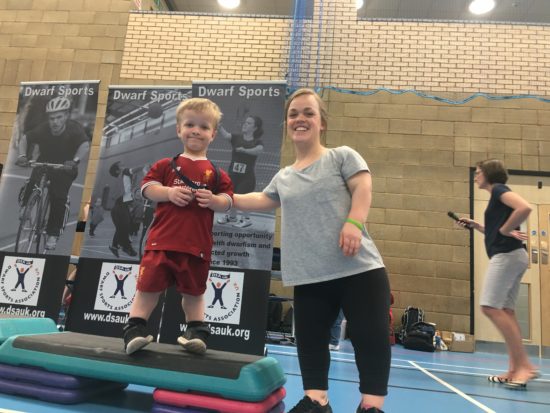
Samuel returned from the DSA this year with a medal for every event he competed in, this was such a boost and encouragement for him. Ellie Simmonds (GB Paralympic swimmer), and Patron of the DSA even presented him with one of his medals.
(Samuel’s medals- Gold: 20 metres running, Silver: 10 metres running, Silver: new age curling, Silver: cycling, Gold: football, Gold: hockey)
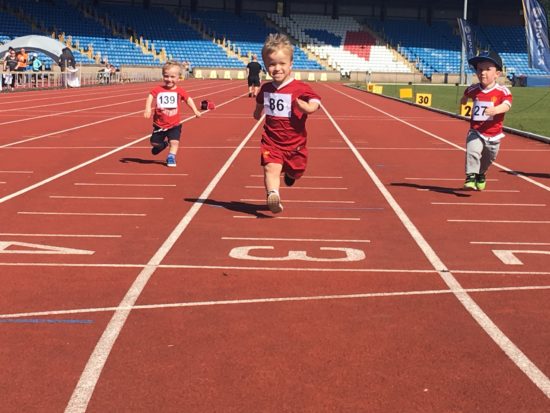
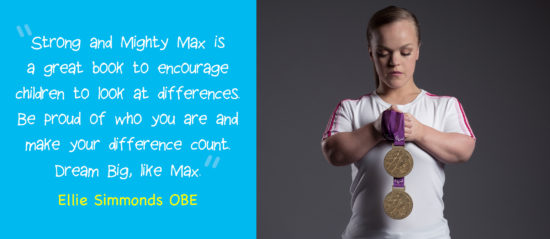
Celebrity endorsements for edition two of Strong and Mighty Max
Sporting celebrities Ellie Simmonds and Jahmani Swanson have both agreed to endorse edition two of Strong and Mighty Max.
Ellie is a British Paralympian Swimmer who was born with achondroplasia like Max. She has become famous around the world for her Paralympic success, competing in S6 swimming events. She made her debut on the world stage at the age of 13, when she competed for Great Britain in the 2008 summer Paralympics in Beijing, winning two Gold medals. Her success continued in 2012 at the London Paralympics when she won another two Golds, including setting a World Record in the 400m freestyle. The most recent Paralympics held in Rio in 2016 Ellie went on to win another Gold, this time setting a world record for the 200m medley.
Ellie continues to be a great role model for young people, and plays a vital role as patron of the Dwarf Sports Association (DSA) where she spurs young people on to achieve their dreams in competitive sport.

Jahmani Swanson, otherwise known as Mani Love, became famous for his skills and talent on the basketball court. In 2017 he signed with the Harlem Globetrotters. Born with dwarfism, like Max, he is 4-foot-5 inches tall and is arguably the shortest professional basketball player in the world.
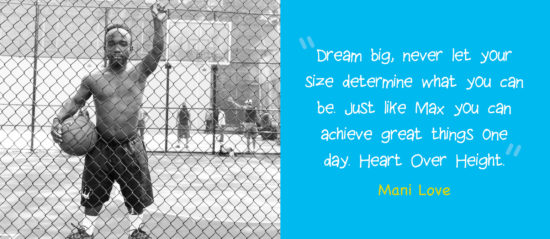
Both Ellie and Jahmani feature as positive role models in the learning activities at the back of the book, and you can learn more about their success by watching the videos which feature in the learn section of this site.
Edition Two of Strong and Mighty Max will be available later this year from online retailers: Waterstones.com and Amazon.com. The book will also be available as an e-book which can be downloaded from amazon. To register your interest in the second edition of this children’s story, click here.
When Everything Was New
We did not find out that our son had suspected dwarfism until he was born. I remember those early days so well-being thrust into a new world that I had never thought about before. We knew so little and yet before long we were to become experts about achondroplasia, a word that was new to us and many of our friends and family. There was a 1 in 25,000 chance of us having our son born with achondroplasia. The same chance as anyone else who are parents and do not have a family history of the condition. Our baby was rare, so rare that not all the health professionals that we were to encounter in the early days knew much about the condition.
Achondroplasia was not in our genes, in fact our baby was a result of a genetic mutation that happened at conception. His DNA was known before he began growing in my womb, however medical technology does not pick it up until around 28 weeks on scans. So most children born with the condition are not diagnosed prenatally. Having a baby was not new to us, our first venture into parenthood was the surprise of non identical twin girls. But perhaps an even bigger surprise was our much loved boy. I don’t think I had ever met someone with achondroplasia before. I read that the condition was classed as a disability- another new term in our family. I read so much online in those early days, a lot of which was not helpful to a mum coming to terms with a diagnosis she wasn’t expecting.
I guess the reason why I am writing this today is for other parents who may have found my blog and have also found themselves on a new journey, a road they perhaps had not planned. Coming to terms with a change in trajectory can have its mixture of emotions and initially you may find yourself taking steps forward a day at a time as you readjust to this new place. Many new parents find this poem a helpful explanation.

My journey has moved along steadily from being informed so that I could best care for my child. These guidelines were perhaps the most helpful read in the early days, followed by meeting with a specialist at Great Ormond Street Hospital (GOSH) who reassured me of what medical issues I was to look out for and reminded that I was not to worry but to enjoy my son. In fact after that meeting I never looked back and the joy has been indescribable at times. (Thank-you Dr Wallis)
So the newness continues- our family have made new friends, attended sporting events and social gatherings that we would have never done before. Our respect has grown for geneticists, researchers, bloggers and charities that advocate on behalf of minority concerns. Our eyes have been opened to a new understanding of what life is like for people who have been born with a disability. I have watched videos that explain my son’s condition, and read books that promote understanding of difference. I would highly recommend the story ‘Wonder’ by R.J.Palacio. The word dwarfism is not mentioned once and yet the similarities of seeing through the lens of someone born with a physical difference is powerful for everyone to read.
I for one have become passionate about the language that is used in the media to describe someone with my son’s condition. Educating other people has become a way of life, challenging mindsets of the beauty of difference and valuing each person that you meet has become a new norm for me and my family. Knowing that every person you encounter has a story has taken on a whole new meaning for me. The importance of taking the time to listen, engage and be sensitive to others whose lives and backgrounds are different to my own is a new priority in my life. Above all things my appreciation of kindness is greater than ever before, knowing that a kind word and gesture are perhaps the greatest legacy we can ever leave behind.

Becoming an author was new for me too. Not something I had planned or aspired to, but something that I have enjoyed nevertheless. Telling a story that educates children and their parents about my son’s condition has been a joy. Seeing my own children read the story to their friends, and above all my son owning it as a way of communicating his difference has given me tremendous satisfaction. If you find yourself on a new journey, perhaps an uphill struggle at times. Let me encourage you with these words, ‘often the most challenging journeys lead to the most beautiful destinations’. Don’t lose heart, embrace the new one day at a time and just see how much richer your story will become.
Edition Two of Strong and Mighty Max, seeks to encourage children to value kindness above all other attributes. It encourages young minds to take the time to learn from others and celebrate differences. After all, the world would be a boring place if we all looked the same.
Debra Keenhan- role model in dwarfism community
Debra Keenahan is an academic and artist whose dwarfism looms large in her work.
For more information, check out her excellent interview with ABC and read her essay ‘The female dwarf, disability, and beauty’.
Read the Restricted Growth Association’s interview with Debra here

Dream Big: Dr Michael Ain
Video: Hamish McClean
Dream Big is a theme in the story Strong and Mighty Max. Hamish McClean achieved his dream; Paralympic swimmer for New Zealand.
Hamish encourages young people to reach for their goal in life.

